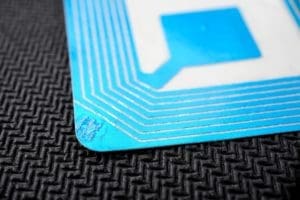 As National Cybersecurity Awareness Month wraps up, it’s important to remember that cybersecurity goes beyond your laptop and your smartphone. Even as mundane an object as your office security fob is potentially vulnerable to a cyberattack—likely not something contemplated in the early 1970s by the holder of the first RFID patent, Charles Walton.
As National Cybersecurity Awareness Month wraps up, it’s important to remember that cybersecurity goes beyond your laptop and your smartphone. Even as mundane an object as your office security fob is potentially vulnerable to a cyberattack—likely not something contemplated in the early 1970s by the holder of the first RFID patent, Charles Walton.
“RFID” stands for radio frequency identification technology. Today, RFID chips are ubiquitous, and their technological roots can be found in the radar detectors of World War II-era planes. Although several individuals had worked to perfect the technology, Walton received a patent in 1973 for a “portable radio frequency emitting identifier” that is considered the first RFID-related patent, and a patent issued to him in 1983 was the first to use the term “RFID.” The 1973 patent was for an electronic door key—the ancestor of your office security fob.
Walton’s RFID journey
A ham radio enthusiast, Walton was born in England and became a U.S. citizen in 1944 while serving in the U.S. Army Signal Corps. He went to work for IBM, leaving in 1972 to start his own company, Proximity Devices. His RFID invention was an alternative to bar code technology, though more expensive for companies to implement as part of inventory management. (For instance, when it came to scanning supermarket products in the 1970s, a bar code cost 25 cents vs. $1.75 for an RFID card.)
He promoted his technology to General Motors, but the GM board reportedly deemed it “too Buck Rogers.” Success came in the form of a partnership with the Schlage lock company.
Unfortunately for Walton, his patents ran out in the mid-1990s before major players including Walmart and the U.S. Department of Defense began requiring suppliers to use RFID for inventory. That said, in a 2004 interview he stated, “I feel good about it and gratified I could make a contribution.” He passed away on Nov. 29, 2011.
Photo: Nor Gal / Shutterstock
